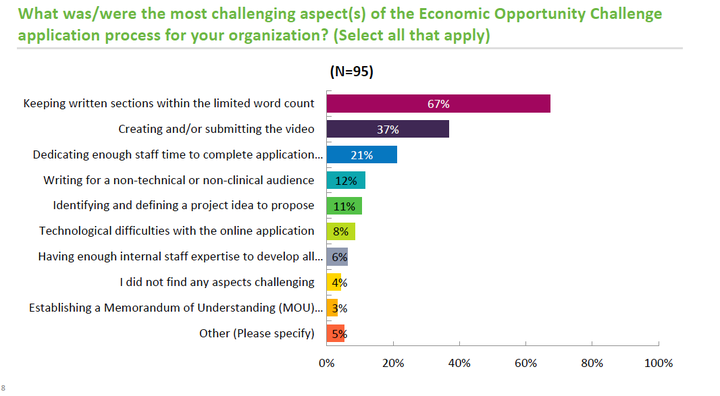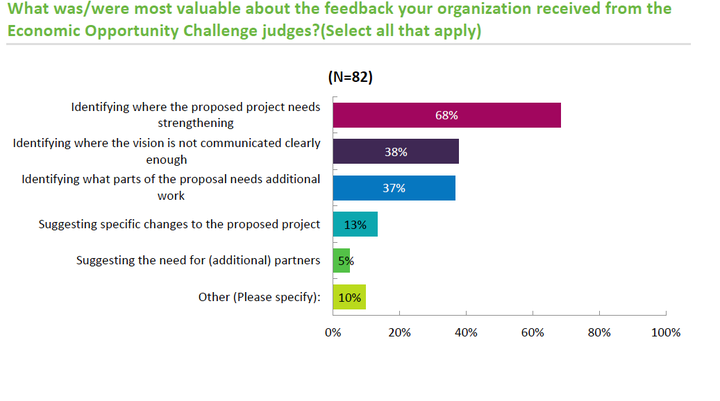Among the guiding principles that we hold in high regard is ensuring that any organization that applies to our competitions finds value in participating. This added value is built into the entire competition process. It starts with an organization’s decision to apply and flows throughout our application and review processes—providing transparent eligibility requirements and a “Smart Application” that supports all participants, as well as sharing reviewer feedback with applicants.
Transparent Eligibility Requirements
Every competition that we run at Lever for Change includes an organizational readiness tool that can help applicants determine if they are a good fit for the particular competition. We are aware that organizations make tough choices about where to spend their time and we do not want them wasting valuable human resources on a competition for which they may not be competitive. Some competitions have a higher threshold for evidence. Some seek community leadership. Some have very broad themes or topics, while others are narrow. A recent survey of applicants for the Economic Opportunity Challenge showed that 94% of respondents found our organizational readiness tool helpful in determining if they should apply to the competition.
Smart Application
We are constantly learning from our competitions and building fair, but rigorous processes that support applicants, expert reviewers, and donors. While 86% of applicants in the Economic Opportunity Challenge survey told us that the level of effort for the application was appropriate for the scale of the award, some people have questioned the length and purpose of our process. They have asked why we require videos and why we don’t ask applicants to submit a shorter, more generic concept note.
There are several reasons why we choose to follow a rigorous application process. Most importantly, through competitions, we are trying to help donor-sponsors find projects outside their existing networks and create a level playing field for all the organizations that apply. We do this by ensuring that all applicants can be compared to each other, using clearly defined criteria. Brief concept notes that are inconsistent from one application to another do not provide enough information for reviewers to give clear feedback. In our experience, processes that ask for less information up front tend to favor institutions that have existing relationships with the donor or have strong brand recognition. In competitions where we have tried to reduce the length of the application, both expert reviewers and donor-sponsors felt they did not have the information necessary to provide feedback or, in the donors’ case, select finalists from a large pool of applicants.
Applicants tell us that they want more space, not less, to explain their work. Recently, this point was cited as the most challenging aspect of completing the Economic Opportunity Challenge application. Many grant-seeking organizations, regardless of size and experience, find it difficult to clearly communicate complex programmatic elements when given limited space.

As a result of feedback from our earliest competitions, we created a “Smart Application” process, which has since become the basis for all our competitions. We designed the application in keeping with best practices in the field, input from experts and consultants, as well as feedback from former and potential applicants.
The Smart Application links to key curated resources that ultimately lead to more successful proposals. As we use a standard set of questions, organizations applying to multiple competitions find that the burden of the application process decreases over time.
When we note areas within the process where organizations struggle to answer questions, we focus on improving the language we use and provide access to resources to help applicants improve their ability to respond. For example:
- Resources for Creating Simple Videos, including instructions on how to turn on automated closed captioning for reviewers who may be deaf or hard of hearing.
- Authentically Incorporating Diversity, Equity and Inclusion
- Building a Theory of Change
- Systems Thinking and Planning for Scale
Our hope is that these tools will add value to the application process, even for organizations that do not advance to the final stages of a competition. If you have additional resources that you think we should include in our process, please contact us.
Evaluation and Feedback
Many grant-seeking organizations find that foundations and funders are not transparent in their decision-making and often provide little-to-no feedback. Nonprofits create proposals or concept notes, submit them, and are simply told that their request for funding has been denied. Often, there is no clear explanation as to why or what the team could do differently to be more competitive in the future.
As part of our added value, Lever for Change focuses on ensuring that applicants know what criteria will be used to assess their proposal before they apply. We also provide increasing levels of feedback as they move through our process. This feedback is designed to be both evaluative and instructive, as well as providing applicants with concrete ways to strengthen their proposals.
In applicant surveys, we have found that feedback helps applicants identify their strengths and weaknesses. Often, this information provides the team with the knowledge they need to continue to strengthen their work or more clearly communicate their project.
One applicant shared that “The feedback was invaluable. It was the first time I received such thorough feedback from a grant maker.”

Continued Learning
Lever for Change is committed to learning and adjusting our processes accordingly. Following the first round of 100&Change, the MacArthur Foundation’s breakthrough $100 million competition, we created our Organizational Readiness Tool which led to stronger applications in the second round of the competition. In an effort to ensure that more applicants receive in-depth feedback, we have incorporated a peer-to-peer review process in all of our competitions. We have also assessed what types of projects have been successful and have built our Smart Application to support applicants in areas where they tend to struggle.
Our competitions aim to strike a balance between the level of rigor necessary for expert reviewers and donors, and the burden this process places on applicants. One of our main goals is to help applicants strengthen their appeal to donors and to deepen the impact of their work. A recent survey respondent shared that “this has been the best run competition that our organization has participated in.” We always seek to do better and look forward to sharing our progress with you.
In the meantime, please read our Applicant FAQ (coming soon) for more information about the competition process and contact us if you have feedback.
